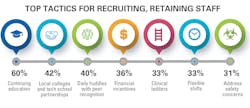Clinical labs are tapping into educational opportunities, financial incentives and perks to attract much-needed personnel.
Those were key takeaways from Medical Laboratory Observer’s State of the Industry Survey on lab management best practices.
Hiring and retaining qualified staff is not easy because lab managers battle labor shortages coupled with steadily growing demand for lab employees.
An aging population is fueling demand for lab tests and, in turn, lab technologists and technicians. The Bureau of Labor Statistics predicts that employment for clinical lab technologists and technicians will grow 11 percent, adding 35,100 positions, from 2018 to 2028. There were 331,700 positions nationally in 2018.
At the same time, current shortages for key personnel exacerbate the situation. Vacancy rates in 2016 varied by department from 4.7 percent in atomic pathology to 10.98 percent for laboratory personnel focused on information systems, quality assurance and performance improvement, according to a survey conducted by the American Society for Clinical Pathology.
In the MLO survey, respondents said they’ve implemented a variety of tactics to recruit and retain staff. MLO also asked survey respondents to rate the effectiveness of each tactic on a five-point scale, with five being the highest score. (Respondents only ranked the effectiveness of tactics they’ve adopted in their institutions).
Another education-related tactic was also common and effective: Offering internships to students from local colleges and technical schools. A total of 42 percent of survey respondents said they have internships. A whopping 61 percent of them assigned the tactic a four or five and 21 percent gave it a 3.
The familiar adage, money talks, is true in labs. Slightly more than one-third, or 36 percent, offer financial incentives to lab employees, such as sign-on or retention bonuses and merit allowances. Most survey participants believe financial incentives are highly effective, with 48 percent assigning the tactic a four or five and 31 percent assigning it a three.
Other tactics lab managers use to recruit and retain staff include daily huddles (40 percent), flexible scheduling (33 percent) and clinical ladders (33 percent), which allow staff to climb steps within a job title, such as from novice to expert.


